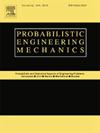A discretized paths-based sequential integration method involving the self-similarity of the fractional Brownian motion
IF 3
3区 工程技术
Q2 ENGINEERING, MECHANICAL
引用次数: 0
Abstract
The discretized paths-based sequential integration method (SIM) is a quite versatile approach for solving various problems, including barrier problems, first passage problems, reflecting barrier problems and so on. This method builds upon the Chapman–Kolmogorov equation and is not applicable to non-Markovian problems, as in the case of fractional Brownian motion (FBM). In this paper, it is shown that the loss of the Markovian property can be overcome by utilizing the self-similarity of the FBM. In order to apply the discretized paths-based SIM, we have to solve a specific stochastic boundary value problem, also called stochastic “bridge” problem, which involves selecting only the trajectories of the FBM that ends at an assigned value, say at , at the beginning of the time interval . It is shown that, due to self-similarity, the stochastic “bridge” problem may be solved only once, regardless of the value at . It is also shown that the trajectories of the stochastic “bridge” problem exhibit self-similarity, which circumvents the loss of Markovian property in FBM, thus allowing the discretized paths-based SIM to be employed without invoking the classical Chapman–Kolmogorov equation. Further, an application involving the classical first passage problem is presented.
一种考虑分数阶布朗运动自相似性的离散路径序贯积分方法
基于离散路径的顺序积分法(SIM)是一种非常通用的方法,可用于解决各种问题,包括障碍问题、首通道问题、反映障碍问题等。该方法建立在Chapman-Kolmogorov方程的基础上,不适用于非马尔可夫问题,如分数布朗运动(FBM)的情况。本文证明了利用FBM的自相似性可以克服马尔可夫性质的损失。为了应用离散的基于路径的SIM,我们必须解决一个特定的随机边值问题,也称为随机“桥”问题,这涉及到只选择FBM的轨迹,该轨迹在指定值处结束,例如在时间间隔tk−tk+1开始时的x ā at tk。结果表明,由于自相似性,随机“桥”问题可能只被解决一次,而不管x在tk处的值是多少。研究还表明,随机“桥”问题的轨迹表现出自相似性,这规避了FBM中马尔可夫性质的损失,从而允许在不调用经典Chapman-Kolmogorov方程的情况下使用基于路径的离散化SIM。此外,还提出了一个涉及经典第一通道问题的应用。
本文章由计算机程序翻译,如有差异,请以英文原文为准。
求助全文
约1分钟内获得全文
求助全文
来源期刊

Probabilistic Engineering Mechanics
工程技术-工程:机械
CiteScore
3.80
自引率
15.40%
发文量
98
审稿时长
13.5 months
期刊介绍:
This journal provides a forum for scholarly work dealing primarily with probabilistic and statistical approaches to contemporary solid/structural and fluid mechanics problems encountered in diverse technical disciplines such as aerospace, civil, marine, mechanical, and nuclear engineering. The journal aims to maintain a healthy balance between general solution techniques and problem-specific results, encouraging a fruitful exchange of ideas among disparate engineering specialities.
 求助内容:
求助内容: 应助结果提醒方式:
应助结果提醒方式:


